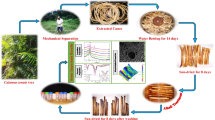Abstract
A new method is developed for the production of composite fibers based on cellulose and vinyltriethoxysilane and formed from N-methylmorpholine-N-oxide solutions. Introduction of the organosilicon additive promotes the activation of cellulose pyrolysis processes, and its choice relies on the presence of a double bond in vinyltriethoxysilane, which can be opened when the temperature rises. Mixed solutions are emulsions with labile droplets of the organosilicon liquid that easily change their shape under deformation. The study of the rheological behavior of the mixed solutions of cellulose with vinyltriethoxysilane reveals an unusual character of a change in viscosity with the concentration of vinyltriethoxysilane—with a minimum at 10–15%. From joint solutions by the dry-jet wet method, composite fibers are spun in an aqueous coagulation bath at a rate of 50–70 m/min. The study of their thermal properties shows that in thermolysis vinyltriethoxysilane additives catalyze condensation processes in cellulose and lead to an increase in char yield. Using IR spectroscopy, the combined chemical transformations of cellulose and vinyltriethoxysilane at all stages of the heat treatment of composite fibers up to 1200°C are analyzed for the first time. It is found that during thermolysis the chemical interaction of vinyltriethoxysilane with cellulose occurs and carbon fibers “crosslinked” by silicon carbide fragments are formed.












Similar content being viewed by others
REFERENCES
H. Mainka, O. Täger, E. Körner, L. Hilfert, S. Busse, F. T. Edelmann, and A. S. Herrmann, J. Mater. Res. Technol. 4, 283 (2015).
L. Golova, I. Makarov, L. Kuznetsova, E. Plotnikova, and V. Kulichikhin, “Structure-Properties Interrelationships in Multicomponent Solutions Based on Cellulose and Fibers Spun Therefrom,” in Cellulose—Fundamental Aspects, Ed. by T. G. M. Van De Ven (InTech, Rijeka, 2013), p. 303.
L. K. Golova, O. E. Borodina, L. K. Kuznetsova, T. A. Lyubova, and T. B. Krylova, Fibre Chem. 32, 243 (2000).
D. N. Chernenko, Candidate’s Dissertation in Technical Science (NIIgrafit, Moscow, 2015).
P. Olri, RF Patent No. 2256013 (2005).
M. E. Kazakov, A. M. Trushnikov, and M. L. Yunitskaya, RF Patent No. 2045472 (1992).
G. Goldhalm, Lenzinger Ber. 90, 58 (2012).
N. Padmavathia, J. Subrahmanyama, K. K. Rayb, R. Mohanrao, P. Ghosal, and S. Kumaria, J. Mater. Process. Technol. 204, 434 (2008).
A. M. Trushnikov, M. E. Kazakov, Yu. F. Gridina, L. D. Vazheva, and L. K. Borisova, RF Patent No. 2047674 (1993).
P. Olri, S. Luazon, M. Kazakov, and A. Trushnikov, RF Patent No. 2258773 (2005).
I. Wizon and J. A. Robertson, J. Polym. Sci., Part C: Polym. Symp. 19, 267 (1967).
I. S. Makarov, L. K. Golova, L. K. Kuznetsova, G. N. Bondarenko, I. Yu. Skvortsov, M. V. Mironova, and M. V. Bermeshev, Fibre Chem. 49, 101 (2017).
I. S. Makarov, L. K. Golova, G. N. Bondarenko, I. Yu. Skvortsov, A. K. Berkovich, M. V. Bermeshev, and M. V. Mironova, Fibre Chem. 49, 231 (2017).
L. K. Golova, RF Patent No. 1645308 (1992).
K. Nakamura, T. Hatakeyama, and H. Hatakeyama, Text. Res. J. 51, 607 (1981).
D. F. Arseneau, Can. J. Chem. 49, 632 (1971).
M. M. Tang and R. Bacon, Carbon 2, 211 (1964).
I. S. Makarov, L. K. Golova, M. V. Mironova, M. I. Vinogradov, M. V. Bermeshev, A. K. Berkovich, and V. G. Kulichikhin, Fibre Chem. 50, 79 (2018).
Funding
The preparation of joint solutions and the analysis of their morphology and rheological properties were carried out within the framework of the State assignment for the Institute of Petrochemical Synthesis, Russian Academy of Sciences (theme no. 3). The preparation of composite fibers and the study of their thermal properties were supported by the Russian Science Foundation (project no. 17-79-30108).
Author information
Authors and Affiliations
Corresponding author
Rights and permissions
About this article
Cite this article
Golova, L.K., Makarov, I.S., Bondarenko, G.N. et al. Composite Fibers Based on Cellulose and Vinyltriethoxysilane as Precursors of Carbon Materials. Polym. Sci. Ser. B 62, 152–162 (2020). https://doi.org/10.1134/S1560090420020037
Received:
Revised:
Accepted:
Published:
Issue Date:
DOI: https://doi.org/10.1134/S1560090420020037




